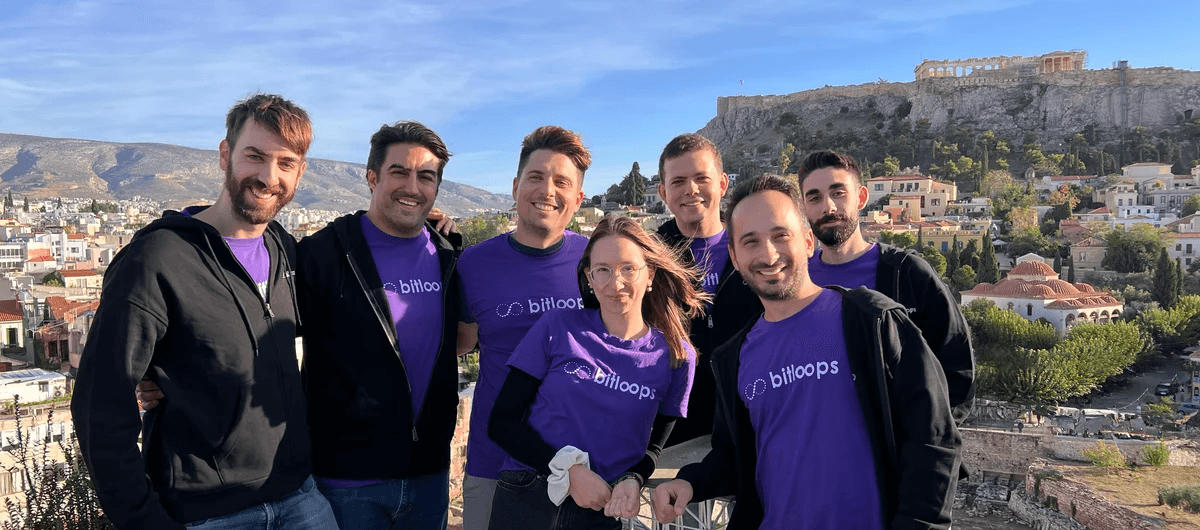Frontend development has become one of the most time-consuming and repetitive parts of modern software teams. Turning Figma designs into clean, production-ready code often requires hours of manual effort, even at the most experienced companies. Bitloops, a startup co-founded by Sergio Pereira and Vasilis Danias between Cyprus and Greece, is setting out to change that. The team recently raised €1 million in pre-seed funding, with Eleven Ventures, Corallia Ventures, and four angel investors contributing, to build a new kind of developer tool that helps engineers move faster without sacrificing quality or control.
In this interview with The Future Media, co-founder Sergio Pereira explains how Bitloops is redefining frontend workflows, why the team is building for a global developer base, and what it takes to turn a tech vision into a real product.
Follow THE FUTURE on LinkedIn, Facebook, Instagram, X and Telegram
Can you share a little about your background?
I’m Portuguese and have been living in Cyprus for the past four years with my wife, who is Cypriot, and our three children. I studied engineering at Imperial College London, where I developed a strong foundation in systems thinking and technology. That period was formative—it not only sparked my love for building and solving problems but also shaped my path toward entrepreneurship.
I began my career at Toyota in Belgium, which gave me a deep appreciation for operational excellence and quality. However, I was keen on exploring the business world, so I decided to do an MBA at INSEAD in France. From there, I moved to Dubai and worked as a management consultant at BCG and Roland Berger, advising companies across a range of sectors and geographies. It was intense and intellectually rewarding, but I soon realized I wanted to be on the side of actually building things, not just advising.
That led me to co-found ComparaJá.pt in Portugal, a price comparison platform for financial products such as insurance, loans, and credit cards. It was my first deep dive into the startup world, where I experienced firsthand what it takes to launch and scale a product in a competitive market. Later, I was headhunted by FREENOW, a leading ride-hailing platform, to launch the company’s operations in Portugal. I served as the General Manager, overseeing everything from market entry to product execution and team growth in a fast-moving environment.
Now, with Bitloops, I’m channeling everything I’ve learned into a product that solves a real pain point for developers. Building the company between Greece and Cyprus has also deepened my appreciation for the talent and potential of this region, and I’m excited to be building something with global impact from here.
For readers who may not know the company yet, how do you usually introduce Bitloops?
I usually say that Bitloops is a developer-first copilot for frontend engineering, but that’s just the starting point. What we’re really building is a way to compress weeks of frontend work into minutes, without sacrificing quality or control.
The product takes a Figma design and generates production-grade frontend code that’s clean, reusable, and modular. It respects the design system, applies proper architecture, and produces something that a developer can immediately build on, not something they need to clean or rewrite. What sets us apart is that we don’t treat this as a one-off translation. We understand how developers work and aim to enhance that workflow.
In practice, this means teams can move from design to deployment faster than ever. They can build more, test more, and iterate faster. Developers are no longer stuck doing repetitive and tedious tasks and can focus on what they do best: solving problems, building features, and improving user experiences.
We’re not replacing developers but freeing them. And in doing so, we’re pushing software development into a new era of speed, experimentation, and creativity.
What specific gap in the developer experience were you trying to close with Bitloops?
The current process of building a frontend interface from a custom design is incredibly meticulous and time-consuming. Developers today have to constantly switch between the code editor and the design file, zooming in on margins, font sizes, colours, paddings, image dimensions, and spacing. They manually extract icons, download fonts, match colour values, and replicate shadows, borders, background gradients, and responsive layouts.
Beyond aesthetics, they also have to ensure the application performs well across screen sizes. That means structuring components to adapt across breakpoints for mobile, tablet, and desktop. And then there are the “invisible” layers: accessibility tags, keyboard navigation support, semantic HTML for SEO, lazy loading for performance, and more.
It’s a detailed, repetitive, and mentally draining process that leaves very little room for creative thinking.
With Bitloops, we automate all of that. Developers receive production-grade code that matches the design precisely. The developers can then refocus their energy to interactivity, business logic, and user experience. We’re eliminating the grind so teams can build better software, faster.
You started this from Cyprus, but it’s clearly built for a global audience. When did you start thinking beyond the local market?
We’re proud to be building this from Cyprus and Greece, and we believe Bitloops can bring tremendous value to local developers and companies. However, our mindset has always been borderless. From day one, Bitloops was designed as a global product. We’re building a SaaS platform and a developer tool—two categories that inherently lend themselves naturally to global scale. The problems we’re addressing around frontend productivity are not specific to any one geography. Whether you’re in Silicon Valley, Berlin, Bangalore, or Limassol, if you’re building modern software, you’re facing the same inefficiencies when it comes to translating design into code.

Our primary focus is on scaling in tech-intensive markets—places with large developer populations and fast product cycles. We’re actively targeting growth in the US, India, Brazil, and other global hotspots where development speed and quality are business-critical.
Who’s using Bitloops today, and what kind of feedback have you received?
We’re currently in closed alpha with about 15 design partners. These include startups building new products, software houses, and agencies that specialise in web development, and in-house IT teams responsible for internal tools and customer-facing platforms. Beyond that, over 100 teams have tested the product so far, and we are continuing to onboard more from our growing waitlist.
We’re also seeing adoption by freelancers, developers, and designers who often wear multiple hats and rely on tools to accelerate their workflow without compromising quality. It’s a broad and diverse user base, which tells us the problem we’re solving resonates widely across different types of teams and company sizes.
The feedback has been consistently encouraging. Developers appreciate that Bitloops doesn’t just give them code; it provides them clean, maintainable, production-grade output that feels familiar. They’ve told us things like, “This is exactly how I would have structured it,” which is a huge compliment in the developer world.
They also value that Bitloops doesn’t force them to change how they work. It integrates into existing workflows and gives them a head start on the most time-consuming parts of frontend development. For us, that is strong validation that we’re solving a real and widespread problem, and that keeps us focused on making the product even better.
At what point did you realize you would need outside capital to keep building Bitloops?
We knew from the beginning that Bitloops would require significant investment, not just because of the complexity of the tool, but because of the high standard we’ve set for production readiness. We’re not aiming to launch a simple MVP to generate buzz. The code we generate needs to be consistently high quality and robust enough to be deployed in real production environments. If our output isn’t trustworthy, teams simply won’t adopt it.
This level of quality takes time. There are countless use cases, variations in how designs are structured, and technical requirements like accessibility, responsiveness, maintainability, and performance. We’re building to support a wide range of edge cases and ensure the code generated adheres to modern development standards.
We also fine-tune our own models and plan to significantly expand our machine learning and AI capabilities over the next few years. Achieving that level of performance while keeping inference costs low is another major area of investment.
That’s why we raised our pre-seed, and it’s also why we’re planning a Seed round in 2026.
How did you go about finding the right investors?
Both Vasili and I have been working in and around tech for the past two decades. Between us, we’ve built and scaled startups and held senior roles at companies like BCG, Toyota, Roland Berger, Accenture, UBS, and Uber. Over the years, we’ve built strong networks of advisors, operators, and investors who understand the realities of early-stage innovation.
Naturally, we started by reaching out to our own network. We also participated in a few accelerator programs and won a startup competition in Istanbul last year, which helped us gain visibility. That said, fundraising, especially in Europe, is significantly harder than in the US. Over the past 18 months, we’ve had dozens, if not hundreds, of conversations with investors.
While we were committed to raising the funds, we were equally focused on finding the right partners. We needed investors who understood the technical demands of our product and the scale of its potential impact. At Eleven Ventures, we found a partner whose lead built a developer tool 20 years ago, so he immediately understood our vision and the problem we are solving. And Corallia Ventures, a newer fund spun out of a prominent Greek innovation hub, brought with it a deep network from the research and high-tech ecosystem. They work closely with universities and R&D institutions and truly understand what it takes to build a product like ours from the ground up.
We weren’t just raising capital, we were building a support system. And I’m proud to say that the investors are already proving to be the right match.
You raised €1M pre-seed. What do you think convinced investors this was a serious product?
I believe it came down to three things: the size of the opportunity, the strength of our team, and the clarity of our strategy. Frontend development is a massive pain point for companies building digital products, and that pain point is only growing. As design tools become more advanced and product cycles accelerate, the gap between design and code continues to slow teams down. Bitloops addresses that problem head-on, and investors quickly saw how large the opportunity could be if we got it right.
But it wasn’t just the vision—it was also our unique approach. From the start, we’ve taken a very deliberate, strategic view of the software development space and where AI copilots can add the most value. We’re not trying to be a generic code generator. We are laser-focused on a specific, high-impact use case: automating frontend development from design specs to production-ready code.
Our approach is technically ambitious, but also deeply practical. We’re not simply layering AI on top of design files—we’re building a system that respects design systems, developer conventions, component architecture, and production-readiness from day one. That makes what we’re building difficult to replicate.
We also brought decades of experience to the table. Vasili and I are both in our early 40s, and between us, we’ve led product, engineering, and business functions at large companies and high-growth startups. We have scaled teams, built software at the enterprise level, and know how to execute under pressure. Investors saw that this wasn’t a side project—it was a serious product being built by a team that understands what it takes to deliver.
Our goal now is to stay focused, keep building, and continue earning the trust of developers.
If Bitloops succeeds, we believe it will fundamentally change how digital products are built. And not just to speed things up, Bitloops will raise the ceiling on what’s possible.













